Drainage
! ! ! See Author's Notes at Bottom of Column ! ! !
Make a Model Of Your Lot
If you take some scrap cardboard and trace the different patterns of a topo map onto the cardboard and then cut out each pattern, you can make a 3D model of a building lot or piece of land. You take the cut out patterns and stack them on top of one another. One of the things that becomes very apparent when you do this is the fact that topographic lines that are spaced closely together indicate a steep hill or a cliff in reality. When you build a model, you will find this out in a hurry! If you have kids and are looking for a neat science project, see if their teacher will let you create a 3D model from a topographic map.
Coastal Lots
If you live or are relocating to a low lying coastal area, you know that the land is usually very flat. Try to see if you can raise up your house 12 or 18 inches from the normal level that everyone else builds. Have some extra dirt brought in and use this to taper the soil away from your foundation out towards your lot lines. The end result will be a very gentle slope that offers you lots of protection if a heavy rain floods all of your neighbors' houses.
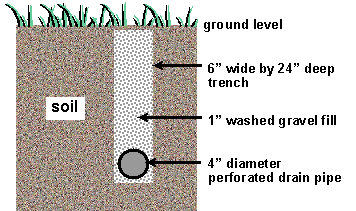
Drainage solution- trench drain.
Soggy Lots
If you have a swampy or soggy lot now and need relief, then you need to look at this drawing.It is a plan or side view drawing of a linear French drain. These simple drainage devices can dry out wet soil in a big hurry.
Keep in mind that water likes to take the path of least resistance. It will flow through gravel much more quickly than through soil. As water migrates from the soil into these trench drains, the water is wicked from adjacent soil towards the drains. The net effect is that your lot dries up.
The backyard of my lot was a swamp each spring. I installed a single linear French drain on the high side of my lot to intercept all of the water that was coming from the land above me. It worked instantly and continues to keep my lot dry as a bone while my neighbor's lot above me is soggy and wet! I keep telling them to install a linear French drain, but they don't seem interested. What was that saying about leading a horse to water?
Drainage issues are critical and they can cost you huge dollars after you move in. It takes some detective work and some thought to figure out what will happen after you move in. Study the land and look at existing subdivisions to see how land forms and shapes affect drainage.
Author's Notes:
You may wonder if my advice is worth anything. Well, read what Jim Sanders wrote to me when he was at the end of his rope:
"Hi, I just wanted to write to give you the results of my "Trench Drain". I have had a wet crawlspace for 15 years. Water would fill the crawlspace at times, so we actually had to drill weep holes at the base so that it would enter the basement and eventually, the sump pump.
I have tried everything. Several contractors said that the only thing we could do was to bring the water into the house via drainage tile and let it enter the sump pump. That would work, but because I live on a 6' elevation, there is no reason that I should have water problems. It became like clockwork...when it rained, we would rush home from the lake or wherever we were vacationing so that we could be prepared to start the backup generator, in case the power failed. We even had our alarm company put a sump alarm on our system, so they could notify us if we had a power failure. Battery backup was not an option, because sometimes we lose power for days and during any rain, our sump would run every 7 minutes...just like clockwork.
I found your site and read the article on the trench or French drain. At first, it sounded a bit like "holistic healing" to me. I failed to understand why a 2 ft. deep trench, 4 ft. away from the house would do any good. How could this simple thing correct an extreme water problem that has plagued me for years, cracked my foundation, settled my garage floor and ruined almost every vacation?
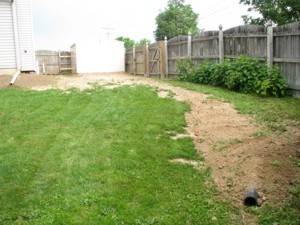
The Linear French Drain trench running from the house. PHOTO CREDIT: Jim Sanders
I decided "what the heck". I had to dig by hand using a trenching spade and a pick-ax, because the builder back-filled our property with brick and blacktop. It took quite a bit of time. Because the ground level varies so much on that side of the house, I was not able to achieve exactly 2 ft. deep. It varied from 18" to 30" in spots, but the slope was downhill. The trench is about 80 ft. long. At times, I thought about filling it all in, because I just didn’t believe that it would work.
I stoned it, put tile in, and filled it with #1 round stone. I socked the pipe just for safety measure and I also used geotextile fabric on top, so I could cover with dirt and grass. I also ordered some clay and pitched from the house to the drain.
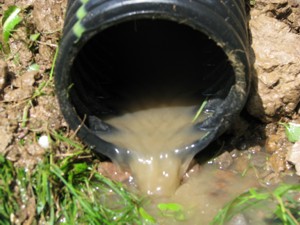
After a short rain, water is running away from the house. PHOTO CREDIT: Jim Sanders
Result? For the last month, we have had 7 or 8 torrential rains, the worst of which was last night. It rained so hard, that our lawn washed out in spots because of the high clay content. Our sump pump, that normally ran every 7 minutes during and after rain, has not turned on for 4 weeks. The silt at the bottom of the sump well is now dry and cracking. Our crawlspace has not shown a trace of water or even moisture.
Since I couldn’t see correcting the foundation cracks or the garage floor settling and tilting until I corrected the problem's source, I waited to see if the trench drain worked first.
This week, I had a company come in and perform sort of a "mud-jacking" technique on the garage floor, which worked perfectly. Also, during the past few weeks, I parged the cracks in the foundation.
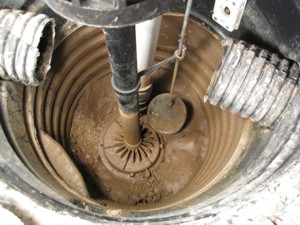
A dry sump pump. PHOTO CREDIT: Jim Sanders
I just wanted you to know how this worked. I stressed for many years over this issue and the solution was nowhere near as difficult as I thought it would be.
As a side note, I went to the end of the drain tile during a hard rain to see what was happening. Water was running out of the drain tile in about the same exact volume that it previously ran out of the weep holes in my crawlspace. This winter will be interesting, because last year, the ground next to the house was so saturated that during a thaw, my sump would run constantly. I'm guessing that the ground between the trench and the house will probably be drier now going into this winter."
- Jim Sanders, Upstate area - New York
CLICK HERE to get FREE & FAST BIDS from local drainage expert contractors.
Column B289
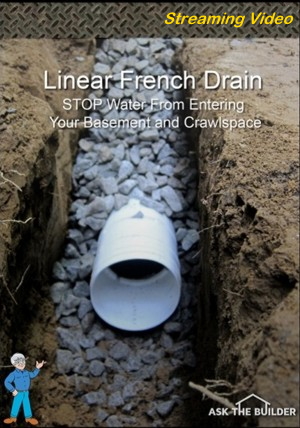
One Response to Drainage